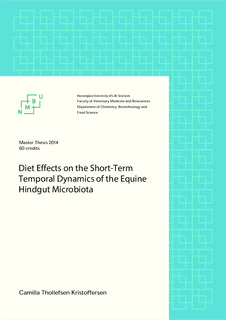| dc.contributor.author | Kristoffersen, Camilla Thollefsen | |
| dc.date.accessioned | 2014-08-12T09:20:50Z | |
| dc.date.available | 2014-08-12T09:20:50Z | |
| dc.date.copyright | 2014 | |
| dc.date.issued | 2014-08-12 | |
| dc.identifier.uri | http://hdl.handle.net/11250/217041 | |
| dc.description.abstract | Horses’ living conditions have changed through thousands of years; altering their diets, that no longer fit the horse’s physiology. Horses were free-ranging grazing animals and their digestive system is therefore adapted to cope with large quantities of fibrous feeds. Mixed roughage and concentrate diets will consequently affect how horses utilize nutrients. In order to optimize feeding rations, it is important to understand how the hindgut microbiota reacts when different diets are presented. The aim of this thesis was therefore to investigate the short-term temporal dynamics of the equine hindgut microbiota by using 16S rRNA gene and shotgun metagenomic sequencing. The microbiota and associated metabolic products were compared to investigate the diet effects on the equine hindgut microbiota, through cecal content collected in a time period of 24 hours from four cecally cannulated horses, given two different diets. Additional fecal samples were also collected in the same time range, to investigate whether fecal samples could represent the microbial population of the cecum. The detected dominant bacterial phyla, in equine cecum, comprised of the predominating phyla Firmicutes and Bacteroidetes, followed by the phyla Verrucomicrobia, Proteobacteria, Tenericutes, Spirochaetes, Cyanobacteria and Fibrobacteres. Based on the observed temporal patterns of the microbiota, we propose a model where the fibrolytic bacteria Fibrobacter succinogenes produce SCFA that lead to a pH decrease in the cecum and the resurgence of lactic acid-producing Streptococcus spp., where ultimately growth of lactate utilizing Anaerovibrio spp. are believed to prevent the accumulation of lactate in the cecum for a prolonged period of time. Further, the cecal content and feces showed significant difference, suggesting that feces cannot represent the cecal microbiota in a proper way. This study provides a foundation for further understanding of the equine hindgut microbiota and its function, allowing production of feeds that are more adapted to this intestinal ecosystem and may prevent diseases in the future. | nb_NO |
| dc.language.iso | eng | nb_NO |
| dc.publisher | Norwegian University of Life Sciences, Ås | |
| dc.subject | VDP::Matematikk og Naturvitenskap: 400::Basale biofag: 470::Molekylærbiologi: 473 | nb_NO |
| dc.subject | VDP::Landbruks- og Fiskerifag: 900::Landbruksfag: 910::Fôring: 918 | nb_NO |
| dc.subject | VDP::Teknologi: 500::Bioteknologi: 590 | nb_NO |
| dc.subject | Horse | nb_NO |
| dc.subject | Feeding | nb_NO |
| dc.subject | Hindgut microbiota | nb_NO |
| dc.subject | Shotgun metagenome sequencing | nb_NO |
| dc.subject | 16S rRNA gene metagenome sequencing | nb_NO |
| dc.title | Diet effects on the short-term temporal dynamics of the equine hindgut microbiota | nb_NO |
| dc.type | Master thesis | nb_NO |
| dc.source.pagenumber | 92 | nb_NO |
| dc.description.localcode | M-BIOTEK | nb_NO |
